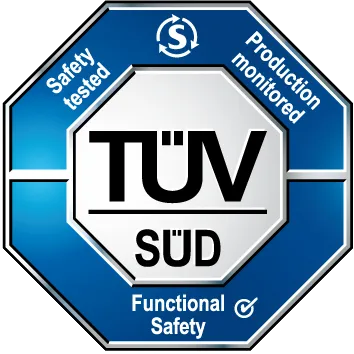CONTRIBUTIONS FROM THE EXPERT
SYMPOSIUM
INTEGRATED &
SAFE MOTION
for MOBILE
ROBOTICS
Here you can watch the videos of the lectures in full length and download the presentations. Simply fill out the form below to access the videos and slide decks of the contributions.
The Speakers and the Topics

Igor Osniszki will present insights into compliance with standards and the safety of machines and robotic systems.
He emphasizes the importance of compliance with standards and comprehensive risk assessment throughout the life cycle of machinery. The presentation outlines the key safety measures, including inherently secure design, technical safeguards, and the provision of user information. Particular attention is paid to safety features for robots, with examples such as power and force limiting. The effort required for security integration varies based on product complexity, with fully integrated components simplifying compliance.
The opportunities lie in the use of pre-integrated components to simplify safety implementation and reduce development time. M&P's presentation highlights the importance of safety integration in ensuring product compliance and improving operational safety.

Synapticon introduces a groundbreaking approach to functional safety in mobile robotics and presents the next-generation architecture for automated guided vehicles (AGVs) and autonomous mobile robots (AMRs).
Andrija Feher, CTO of Synapticon, discusses the core principles of functional safety and emphasizes adherence to safety standards and norms to effectively mitigate risks. Synapticon's innovative architecture is based on Safety Over EtherCAT (FSoE) and offers a paradigm shift towards integrated drive systems and simplified connectivity. By combining servo drives, safety encoders, brakes and motors in a single unit, Synapticon reduces costs, complexity and maintenance while increasing the reliability and performance of the system. The presentation showcases Synapticon's collaboration with industry partners to ensure a wide range of compatible components within the ecosystem. Through strategic alliances and technology partnerships, Synapticon strives to provide its customers with comprehensive solutions tailored to their specific needs. A case study using a Synapticon reference solution demonstrates the practical application of the next-generation AGV/AMR architecture. Through the use of safety PLCs, motion controllers and safety scanners, the system achieves omnidirectional kinematics and real-time speed monitoring, ensuring safe and efficient operation in dynamic environments. Attendees are invited to explore the reference solution and discuss with Synapticon's experts to underscore the company's commitment to innovation and safety in mobile robotics.

Join Tom Finch, CTO and co-founder of Benedex, as he explores the revolutionary concept of modular mobility for the design and construction of mobile robots.
In a world where engineering talent is scarce and time-to-market is critical, Benedex offers a Lego-like system of parts that connect seamlessly to create bespoke intelligent mobile industrial robots for various applications. Discover how modular mobility simplifies the design process and allows companies to focus on innovation without hiring specialized engineers or exposing themselves to the risks of redesigning. Discover Benedex's versatile hardware and software solutions, including smart wheels with integrated motors and control systems, as well as controllers for precise motion control. With Benedex's expertise in engineering services and consulting, companies can efficiently bring their mobile robot concepts to life and seamlessly transition from prototyping to mass production. Watch the full presentation to learn more about Benedex's modular mobility solutions and how they can transform and simplify mobile robotics projects.

Experience the history and development of mobile robotics with Phillipe Piatkiewitz, CEO of VECTIONEER. Starting with simple AGVs (Automated Guided Vehicles) in the 80s, Phillipe discusses the path to autonomous robots with advanced functionalities.
Learn about topics such as SLAM (Simultaneous Localization and Mapping), the integration of sensors such as LiDAR, and the critical role of data in optimizing logistics and machine maintenance. Discover how Vectioneer's modular motion software provides a no-code solution for AGVs and robots, providing OEMs with customizable and adaptable platforms. Gain insight into the future of mobile robotics and learn how innovative technologies can increase efficiency and customer satisfaction. Watch the full video for more inspiration and insight into the possibilities of robotics in various industries.

In this presentation, Lena Bitzek, test engineer at TÜV SÜD, will provide valuable insights into compliance with safety standards for industrial machinery and robotics, drawing on the expertise of TÜV, a renowned testing and certification organization.
With more than 150 years of experience and a global presence, TÜV provides impartial assessments and certification services to companies worldwide. Lena discusses the key safety standards, testing methods, and compliance requirements for different types of robots, including industrial robots, service robots, and autonomous mobile robots (AMRs). By exploring the scope of ISO 3691-4 and other relevant standards, participants will gain a deeper understanding of the security measures required to navigate international markets and meet regulatory requirements. Using real-world examples and a detailed overview of the testing process, Lena emphasizes the importance of thorough risk assessments, documentation, and prototype testing for certification. Attendees will gain practical insights into streamlining compliance efforts and improving safety in industrial environments.

Join Niklas Völker, Systems Engineer for Robotic Applications at Motius, for this insightful session on Edge Systems Engineering for Robotic Applications.
Learn how Motius uses agility and systems engineering to develop innovative robotic solutions – from conception to production launch. Nicholas provides a comprehensive overview of Motius' approach, team structure, and real-world examples that highlight the importance of interdisciplinary collaboration and agile methodologies when navigating complex technological landscapes. Gain valuable insights into downstream systems engineering, team dynamics, and the iterative development process that drives the success of robotic applications. Don't miss this opportunity to learn from the experts at Motius and use the potential of edge systems engineering in your projects.

SICK, a leader in sensor technology, will present insights into security integration for mobile platforms with a focus on compliance and security.
The extensive sensor portfolio includes solutions for navigation, positioning, motion control and handling of low loads. Essential safety features such as emergency stop and person detection are critical to safe operation, highlighting the need for sophisticated safety architectures. SICK discusses various integration methods for safety sensors, from traditional approaches to innovative solutions that use fieldbus communication. Each integration method is evaluated in terms of its advantages and disadvantages, as well as its suitability for different mobile platform configurations. Attendees will gain insights into SICK's vision for future safety integration, including modular control solutions and support for various kinematic configurations. The presentation concludes with an outlook on upcoming developments, such as the integration of control modules directly into safety controllers for efficient operation. SICK's commitment to innovation and safety enables customers to achieve optimal performance and compliance in the operation of their mobile platforms.

Neura Robotics, based in Metzingen, is a pioneer in the field of cognitive robotics. The aim is to make robots accessible and adaptable for various applications, including in the fields of industry, social sustainability and consumers.
The company envisions a future in which robots serve as companions for people in their everyday lives. Neura emphasizes the importance of flexibility in interacting with robots, allowing users to interact with robots in a variety of ways without the need for special programming skills. The presentation addresses the limitations of traditional industrial robots and cobots and highlights the need for more versatile and adaptable robotic solutions. Neura introduces the concept of cognitive robots that are able to solve problems autonomously and collaborate with humans. These robots are equipped with advanced sensors and artificial intelligence to understand and interact effectively with their environment. The company's product portfolio includes cobots, cognitive robots and AGVs (Automated Guided Vehicles), all of which are designed to improve efficiency and safety in various industries. Dr. Alexander Blass emphasizes the importance of local AI processing that enables robots to function independently of internet connections. In addition, Dr. Blass is exploring the potential of combining AGVs with robotic arms to create mobile robotic systems for various applications. The company's ultimate goal is to seamlessly integrate AI into robotic bodies to provide users with intelligent tools to assist them in a variety of tasks.

Fraunhofer IPA presents the potential of engineering tools to automate safety processes, with a focus on hazard detection and risk mitigation.
Compliance with ISO 12100 and machine guidelines underlines the need for comprehensive safety measures. Challenges include the balancing act between safety requirements and the flexibility of robotic systems, which often rely on manual processes and domain knowledge. The bottleneck lies in time-consuming safety assessments and human-centered considerations that lead to potential errors and over-engineering. To overcome these challenges, Fraunhofer IPA proposes to automate safety processes with simulation-based tools. These tools offer intuitive operation, 3D visualization and time savings through automated hazard detection and calculation of safety parameters. The computer-aided risk assessment (CARA) software is an example of this approach and enables the automatic identification of hazards, the placement of protective measures and the estimation of KPIs. By supporting simulations and post-processing, CARA streamlines safety assessment and documentation. In addition, Theo Jacobs will present Robo-Dashcam, a tool for optimizing safety concepts by capturing and analyzing real-world data. By tracking human interactions with robots, Robo-Dashcam identifies optimization potential and provides information for iterative risk assessments. The ultimate goal is fully automated safety processes that use AI and simulation to improve safety and productivity in technical applications.



















SMALL TENSION
SOMANET NODES FOR FUTURE-ORIENTED ROBOTICS
MORE INTELLIGENCE
IN SERVO DRIVES
Our servo drive systems can be combined locally with your own software. This allows you to implement reflexes based on sensor signals and other customer-specific algorithms directly on the drive.

START WITH AN EVALUATION KIT
Test the SOMANET nodes with permanent magnet synchronous motors (PMSM/BLDC) of various sizes up to 2000 W (48 V / 66 Arms) and integrate them as slaves into your EtherCAT system.



- A SOMANET Node with the desired rated power (20 - 100 A)
- Cables
- A handy box
- One OBLAC Drive Box (optional)
